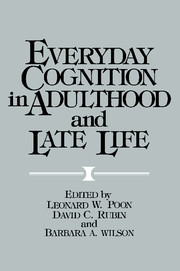Book contents
- Frontmatter
- Contents
- List of contributors
- Preface
- Part I Adult cognitive abilities in the laboratory and in real-life settings: Basic theoretical and methodological issues
- Part IA Systematic approaches to laboratory and real-world research
- 2 Representative design and the quality of generalization
- 3 The myth of external validity
- 4 Functional explanations of memory
- 5 General systems theory: A rationale for the study of everyday memory
- Part IB Combining laboratory and real-world research
- Part II Cognition in adulthood and late life: Findings in real-life settings
- Part IIA Everyday cognitive abilities
- Part IIB Concomitant influences
- Part III Cognitive enhancement and aging: Clinical and educational applications
- Part IIIA Issues and perspectives
- Part IIIB Enhancement approaches
- Part IIIC Designing programs for cognitive rehabilitation
- Subject index
- Author index
3 - The myth of external validity
Published online by Cambridge University Press: 05 October 2013
- Frontmatter
- Contents
- List of contributors
- Preface
- Part I Adult cognitive abilities in the laboratory and in real-life settings: Basic theoretical and methodological issues
- Part IA Systematic approaches to laboratory and real-world research
- 2 Representative design and the quality of generalization
- 3 The myth of external validity
- 4 Functional explanations of memory
- 5 General systems theory: A rationale for the study of everyday memory
- Part IB Combining laboratory and real-world research
- Part II Cognition in adulthood and late life: Findings in real-life settings
- Part IIA Everyday cognitive abilities
- Part IIB Concomitant influences
- Part III Cognitive enhancement and aging: Clinical and educational applications
- Part IIIA Issues and perspectives
- Part IIIB Enhancement approaches
- Part IIIC Designing programs for cognitive rehabilitation
- Subject index
- Author index
Summary
The explosion of interest in everyday memory over the past few years has enormously enriched the field. Entire areas of investigation that were unknown a few years ago – prospective memory, for instance – are boiling with ideas and findings. The excitement of new horizons has been a large part of what has made this conference a delightful intellectual experience.
The new wave of real-world research in memory is, of course, part of a more general trend toward application and social relevance in psychology. Bahrick (Chapter 6, this volume) discusses the history of this trend as a reflection of social forces that affected the scientific enterprise across the board. Specifically within psychology, it is tempting to see it also as a continuation of our progressive liberation from the “snaffles and curbs” of orthodoxy – first structuralism, then behaviorism, then laboratory rigorism (Baddeley, Chapter 8, this volume). Cognitive scientists breathed a sigh of relief when they were given permission to study the mind. We are breathing another sigh of relief as we find that we are allowed, even encouraged (Neisser, 1976), to study interesting things about the mind. We have been turned loose to seek the bloody horse, and we love it.
What is worrisome about this development, however, is that it appears to be hardening into an orthodoxy of its own. Experimenters are being told that their research ought to have real-world relevance, that it must be generalizable to real life, and that a measure of its value is the variance accounted for by its manipulations and measures.
- Type
- Chapter
- Information
- Everyday Cognition in Adulthood and Late Life , pp. 25 - 43Publisher: Cambridge University PressPrint publication year: 1989
- 10
- Cited by



